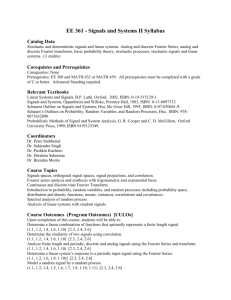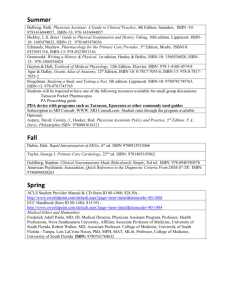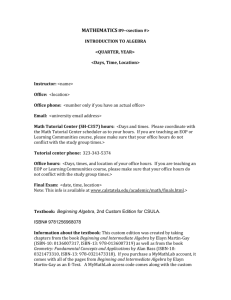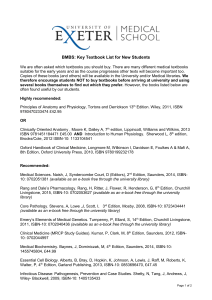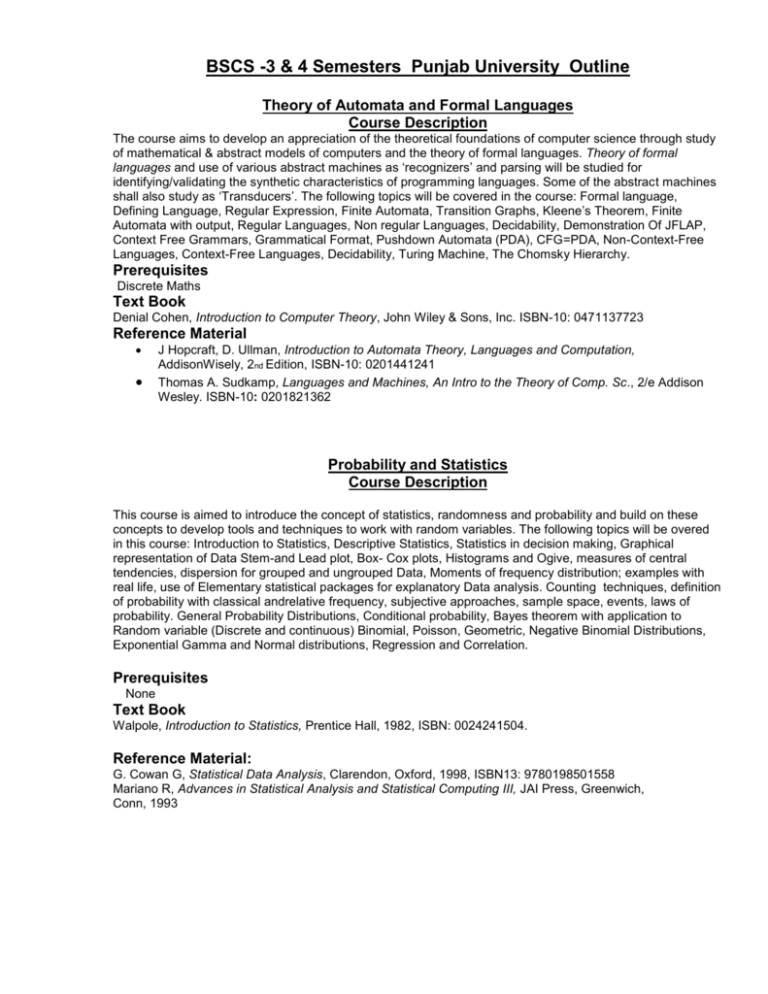
BSCS -3 & 4 Semesters Punjab University Outline
Theory of Automata and Formal Languages
Course Description
The course aims to develop an appreciation of the theoretical foundations of computer science through study
of mathematical & abstract models of computers and the theory of formal languages. Theory of formal
languages and use of various abstract machines as ‘recognizers’ and parsing will be studied for
identifying/validating the synthetic characteristics of programming languages. Some of the abstract machines
shall also study as ‘Transducers’. The following topics will be covered in the course: Formal language,
Defining Language, Regular Expression, Finite Automata, Transition Graphs, Kleene’s Theorem, Finite
Automata with output, Regular Languages, Non regular Languages, Decidability, Demonstration Of JFLAP,
Context Free Grammars, Grammatical Format, Pushdown Automata (PDA), CFG=PDA, Non-Context-Free
Languages, Context-Free Languages, Decidability, Turing Machine, The Chomsky Hierarchy.
Prerequisites
Discrete Maths
Text Book
Denial Cohen, Introduction to Computer Theory, John Wiley & Sons, Inc. ISBN-10: 0471137723
Reference Material
J Hopcraft, D. Ullman, Introduction to Automata Theory, Languages and Computation,
AddisonWisely, 2nd Edition, ISBN-10: 0201441241
Thomas A. Sudkamp, Languages and Machines, An Intro to the Theory of Comp. Sc., 2/e Addison
Wesley. ISBN-10: 0201821362
Probability and Statistics
Course Description
This course is aimed to introduce the concept of statistics, randomness and probability and build on these
concepts to develop tools and techniques to work with random variables. The following topics will be overed
in this course: Introduction to Statistics, Descriptive Statistics, Statistics in decision making, Graphical
representation of Data Stem-and Lead plot, Box- Cox plots, Histograms and Ogive, measures of central
tendencies, dispersion for grouped and ungrouped Data, Moments of frequency distribution; examples with
real life, use of Elementary statistical packages for explanatory Data analysis. Counting techniques, definition
of probability with classical andrelative frequency, subjective approaches, sample space, events, laws of
probability. General Probability Distributions, Conditional probability, Bayes theorem with application to
Random variable (Discrete and continuous) Binomial, Poisson, Geometric, Negative Binomial Distributions,
Exponential Gamma and Normal distributions, Regression and Correlation.
Prerequisites
None
Text Book
Walpole, Introduction to Statistics, Prentice Hall, 1982, ISBN: 0024241504.
Reference Material:
G. Cowan G, Statistical Data Analysis, Clarendon, Oxford, 1998, ISBN13: 9780198501558
Mariano R, Advances in Statistical Analysis and Statistical Computing III, JAI Press, Greenwich,
Conn, 1993
Object Oriented Programming
Course Description
The course aims to focus on object-oriented concepts, analysis and software development.
The following topics will be covered in the course: Evolution of OO, OO concepts and Principles, problems
solving in OO paradigm, OO program design process, Classes, Methods, Objects and encapsulation,
Constructors and destructors, operator and function overloading, virtual functions, derived classes,
inheritance and polymorphism, I/O and file processing, exception handling
Prerequisites
Introduction to computing, Programming Fundamentals
Text Book
Budd, Understanding Object Oriented Programming, Addison Wesley
Reference Material
Bruce Eckel, “Thinking in C++”, 2nd Ed, Pearson Publication, ISBN 0-13-979809-9
P J Deitel & H M Deitel, “C++ How to Program”, 4th Ed., Prentice Hall, 2001. ISBN 0130384747
Linear Algebra
Course Description
The purpose of this course is to provide a solid foundation in Linear Algebra. It will enable the students to
master the concepts and to know when and how to apply linear algebra. Applications are taken from such
areas as Cryptography, Fractals, Chaos, Computer Graphics, Game of Strategy, Computer Tomography,
Warps and Morphs. The Software MATLAB will be used for the implementation of Linear Algebra. The
following topics will be covered in this course: Introduction to Linear Algebra (History, differentiation between
Matrix Algebra and Linear Algebra), Concept of a matrix with real entries, Operations of matrices (Addition,
multiplication, scalar multiplication, trace, transpose), Determinant of a matrix and its properties. Singular and
non-singular matrices, Row/Column elementary Operations defined on a matrix Inversion of a matrix (by
elementary operations), Reduction of matrix into echelon and reduced echelon
form by elementary operations. Rank of a matrix, Introduction to system of linear equations, Solution of
system of linear equations by Gauss elimination method, Concept of algebraic Structures (Semi group,
Group, abelian group), Sub groups, Cosets, Mappings, Ring and Field, Introduction to vector spaces, Linear
combination, linear span, Linear dependence and independence of vectors, Concept of basis and dimension,
Linear transformations, Kernel and Range, Matrix representations of a linear transformation, Matrix
transformations (dilation, contraction, reflection, compressions and expansion), Affine Transformations
(Shearing, Scaling, Rotation, and Translations), Concepts of Eigen value and eigenvector, Characteristic
equation, Eigenvalues of an upper & lower triangular matrix, Diagonalization of matrices, Matrix Functions,
Concepts of Norm and inner product space.
Prerequisites
Calculus – II
Text Book
Anton - Rorres “Elementary Linear Algebra, application version”. 8th Edition, John Wiley & Sons, Inc.
2000, ISBN: 978-0-471-44902-7
Reference Material
David C Lay, Linear Algebra, Pearson Addison Wesley, 1999, ISBN: 0201660369
Discrete Mathematics
Course Description
This course introduces the foundations of discrete mathematics as they apply to Computer Science, focusing
on providing a solid theoretical foundation for further work. It aims to develop understanding and appreciation
of the finite nature inherent in most Computer Science problems and structures through study of combinatorial
reasoning, abstract algebra, iterative procedures, predicate calculus, tree and graph structures. The following
topics will be covered in the course: Introduction to logic and proofs, Direct proofs, proof by contradiction,
Sets, Combinatorics, Sequences, Formal logic, Prepositional and predicate calculus, Methods of Proof,
Mathematical Induction and Recursion, loop invariants, Relations and functions, Pigeon whole principle,
Trees and Graphs, Elementary number theory, Optimization and matching, Fundamental structures,
Functions (subjections, injections, inverses, composition), relations(reflexivity, symmetry, transitivity,
equivalence relations), sets (Venn diagrams, complements, Cartesian
products, power sets), pigeonhole principle; cardinality and countability.
Prerequisites
None
Text Book
Rosen, Discrete Mathematics and Its Applications, 5th edition, 2002, McGraw-Hill, ISBN: 0072424346
Reference Material
Richard Johnsonbaugh, Discrete Mathematics, Prentice Hall, 1996, ISBN: 0135182425
Kolman, Busby & Ross
Data Structures and Algorithms
Course Description
This course is designed to teach students structures and schemes, which allow them to write programs to
efficiently manipulate, store, and retrieve data. “An apprentice carpenter may want only hammer and saw, but
a master craftsman employs many precision tools; (Robert L. Kruse Data Structure and Program Design)”.
Computer programming likewise requires sophisticated tools to cope with complexity of real applications and
only practice with these tools will build skill in their use. Topics: Introduction: Introduction to Course, Review of
Object Oriented Programming Concepts. Algorithm Specification: Properties of Algorithm, examples,
performance, analysis, measurement, and Big Oh notation. Introduction to ADTs: Array and Polynomial as an
ADT, and Representation of Arrays. Stack ADT, Expressions, Postfix Notation, and Infix to postfix conversion.
Recursion: Recursive Definition and Processes, Writing Recursive Programs. Queue: The Queue ADT,
Circular and Double Ended Queue. Self-Referential Classes, Linked List: Linear/Circular Singly/Double
Linked Lists, Linked Stacks and Queues. Trees: Introduction to Trees, Logical construction and Traversing of
Binary Trees, Implementation of Binary Trees (Insertion and Traversing), Searching and deletion in Binary
Trees, Binary Search Tree, Introduction to Balanced and AVL Trees. Heaps: Heaps and Heaps as Priority
Queues, Double Ended Priority Queue. Hashing: Hash Functions: Division; Overflow Handling: Chaining;
Introduction to Some advance topics like: B-Trees, Indexing, Sets, Compression and Network Flows etc.
Sorting Types and Techniques: Logical and Algorithmic Implementation of Selection, Bubble, Insertion, Shell,
Radix, Merge, Quick, Heap, and Tree Sorts. Graphs: Graph terminology, Adjacency List and Adjacency
Matrix and Adjacency list representation of Graph; Elementary Graph Operations: Breadth First Search and
Depth First Search, Spanning Trees
(BFSST, DFSST), Minimum Cost Spanning Trees.
Prerequisites
Object Oriented Programming
Discrete Maths
Text Book
Tenenbaum, M. Augenstein, and Y. Lang Sam, “Data Structures using C and C++” 2nd Ed.,
Prentice Hall, 1999, ISBN-10: 0130369977
Reference Material
Frank M. Carrano , Paul Helman Robert Veroff Data Abstraction and Problem Solving with C++ 2nd
edition Addison Wesley
Robert L. Kruse Data Structures an d Program Design ISBN 100137689950
Computer Organization and Assembly Language
Course Description
The main objective of this course is to introduce the organization of computer systems and usage of assembly
language for optimization and control. Emphasis should be given to expose the low-level logic employed for
problem solving while using assembly language as a tool. The students will be capable to acquire knowledge
that is specific to Intel 80x 86 processor families, as well as knowledge that is universal. They will learn the
programming methodologies showing how to use Assembly Language for Application Software’s, System
Programming and Terminate and Stay Resident. They will develop programs based on the interaction
between Assembly Language and Operating System, Security Software’s, encryption and decryption
programs, programs for Reverse Engineering, programs for small scale Embedded Systems and Games
specially Networking Games using serial and parallel ports. Following topics will be covered in this
course: Processor Architecture and Organization, Memory Architecture, Intel 8086 Registers, Addressing
Modes, Memory Addressing, MOV The Basic Instruction, Debugger, Mathematical and Bit wise Logical
instruction, Stack Instructions, Interrupts, Memory Models, Practice of Program Writing and Debugging,
Control Transfer and Conditional Action Instructions, Procedures, Macros, Shift and Rotate Instructions,
Procedures to Input and Display Binary, Decimal, Hexadecimal Numbers, Reading DOS Command Tail, Data
Communication, File Handling, Recursion, High–Level Logic Structures, Interfacing of Assembly and C++ ,
Languages, Storage of Real Numbers, Math co-processor, String instructions, Introduction to Machine Code,
Protected Mode, Terminate and Stay Resident Programs, Micro Controller Programming (8051)
Prerequisites
Digital Logic Design
Text Book
Barry B. Brey, 'The Intel Microprocessors, 8086/8088, 80186/80188, 80286, 80386, 80486, Pentium
and Pentium Pro Processor ISBBN 100139954082
Kip R. Irvine, Assembly Language for Intel Based Computers, third Edition, Prentice-Hall Publishing,
1999,ISBN-10:0132383101
Reference Material
Assembly Language Reference by Que. Corporation
I Scott Mackenzie, Raphael C.-W.Phan, 8051 Micro-controller Programming, 3rd Edition, ISBN
10:0137800088
Communication Skills
Course Description
The aim of this course is to develop good English writing, language usage and reading skills, to appreciate
the importance of business communication and to develop understanding of communication concepts,
principles, theories and problems. It will also help in developing good oral communication and presentation
skills. The following topics will be covered in the course: Principles of writing good English, understanding the
composition process, Comprehension and expression, Use of grammar and punctuation, Process of writing,
observing, audience collecting, composing, drafting and revising, persuasive writing, reading skills, listening
skills and comprehension, skills for taking notes, Business communications, planning messages, writing
concise but with impact, Letter formats, mechanics of business, letter writing, letters,
memo and applications, summaries, proposals, writing resumes, styles and formats, oral communications,
verbal and nonverbal communication, conducting meetings, small group communication, taking minutes,
Presentation skills, Presentation strategies, material gathering, material organization strategies, time
management, opening and concluding, use of audio-visual aids, delivery and presentation.
Prerequisites
None
Text Book
Vawdrey, Stoddard, Bell, Practical Business English, ISBN-10: 0256102740
Reference Material
Herta A. Murphy, Effective Business Communication, ISBN-10: 007044398X
Business and Technical Writing
Course Description
The objective of this course is to upgrade students’ ability to write effectively in the world of science,
technology and business, to produce experts and specialists in the business and technical writing, to enhance
students’ skills for the effective delivery of technical information to audience (listeners or viewers). It will help
the students to generate thorough understanding of common types of reports, special format items and other
technical features of business documents, to develop verbal and non verbal communication skills for an
effective display of personality. The following topics will be covered in the course: Business communication
overview, Communication and organizational effectiveness, Process of creating effective messages, five
planning steps and organizational plans, Different Forms of Written communication including Persuasive
messages, Good News and Neutral messages, Bad News, Memorandum writing, Letter writing, Informative
and positive messages, Academic, research and business
proposals writing, Formal Report Writing, Business Research Methods, Documentation and Research
Citation, Oral presentation, Strategies for an effective Audience Analysis, Non-verbal communication,
Employment communication, Cross-cultural communication, Business Communication and the Ethical
Contexts.
Prerequisites:
None
Text Book
Greenfield, T., Research Methods, Guidance for Postgraduates, Arnold, 1996, ISBN-10:
0340806567
Arabic Language
Course Description
The main objective of this course is to give students an introduction to the basic syntax and morphology of the
Arabic language so that they can study the language at an advanced level on their own. At the end of the
course students will be in a position to understand simple Arabic sentences and decipher the meaning of
complex sentences to some extent with the help of a dictionary. Although the main stress shall be on
explaining the sentence structure, it is expected that some use of Situational Language Teaching (SLT) and
communication will also give the students a limited ability to read Arabic texts and communicate in that
language. The following topics will be covered in the course:
Prerequisites
None
Text Book
Standard textbook by Punjab University
Reference Material
None

